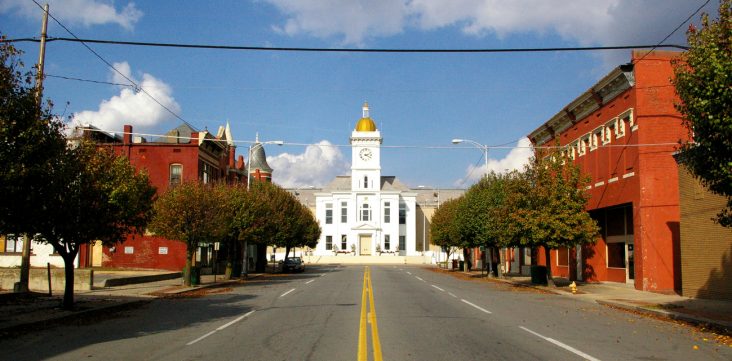Pine Bluff shrinking, but looking to the future
by August 31, 2021 9:01 am 5,854 views

Pine Bluff saw the largest population drop of any metropolitan area in the nation, according to a New York Times report that compared 2020 census numbers with those from 2010. But city leaders are encouraged by the opening of the new Saracen Casino Resort as well as other city improvements they hope will reverse the trend.
The Times reported that the city’s 12.5% decline from 49,083 residents in 2010 to 41,253 in 2020 was the nation’s worst. The story noted the city had suffered from a decline in agriculture and manufacturing employment, reducing its tax base. More bad news included the state’s takeover of the Pine Bluff and Dollarway School Districts and the city’s high homicide rate.
Mayor Shirley Washington doesn’t deny any of that is happening. She says the city lost population most heavily during the first part of the decade; at one point she was hoping it wouldn’t drop into the 30s. People have been moving out and not coming in. Younger adults of child-bearing age like her three children, all area college graduates, have moved away. Older adults who can no longer take care of themselves have moved away to live with their children.
She said residents are leaving to pursue job and educational opportunities, and crime has been a problem. The city suffers from very low housing stock.
“The same issues that have led people to leave the community over the past couple of decades are the same issues that have prevented others from moving in,” she said.
However, Pine Bluff has a lot going for it as well. It’s 40 minutes from Little Rock, accessible by I-530, and is located alongside the Arkansas River with a slackwater port. It’s a college town and home of the University of Arkansas at Pine Bluff and Southeast Arkansas College. It has the casino, Jefferson Regional Medical Center, parks and recreational activities. The city has attempted to revamp its downtown and remove commercial and residential blight, Washington said. It has a new library and an aquatics center. She’s hoping the city reverses its trend and grows to 45,000 in the next census.
“The community is pregnant with possibilities,” she said.
Like Washington, Allison Thompson, president and CEO of the Jefferson County Alliance, an economic development organization, believes much of Pine Bluff’s population loss occurred in the first part of the decade. People moved out because jobs were scarce, many of them sent overseas. Pine Bluff like other rural areas lost population to urban centers.
But the area has had some good economic news lately. In August 2020, Saracen announced it would hire about 800 new workers and eventually employ about 1,200 total. Tyson Foods recently announced it would expand its poultry plant by 70 employees. Good Day Farm, a medical marijuana cultivator, opened this year after announcing that it planned to employ up to 200. Cornerstone Processing in November 2019 announced it was opening a poultry processing plant that would hire up to 150 employees. It’s hiring now.
Thompson noted that Pine Bluff features a long established industrial park, a municipal airport, and a strong Union Pacific railroad presence with a switchboard and track. Wehco Media and Ritter Communications are both offering broadband internet services.
“We now have redundant fiber, and that’s critical when you’re talking about attracting technology companies is having redundant fiber. …. If your business is technology, you have got to make sure you don’t go down. Being able to contract with two different companies is a huge plus,” she said.
Headquartered in Pine Bluff, Simmons Bank has grown from $3 billion in assets to $25 billion in eight years and now has 196 locations across six states. It finally reached the point where it outgrew Pine Bluff’s labor market and bought the Acxiom building in Little Rock, which is now full. CEO George Makris said Simmons Bank continues to invest heavily in Pine Bluff nonprofit and charitable agencies.
Makris has offices and homes in both cities. He still votes in Pine Bluff, chairs the Jefferson County Economic Development Corporation, and serves on the Jefferson County Regional Medical Center board.
He said the schools in Pine Bluff remain the biggest issue and the reason physicians won’t locate there. He said the shrinking city must manage the way it downsizes. With fewer residents, it will have to repurpose its land usages.
Makris also sees good things happening in Pine Bluff. The casino will employ people using skill sets possessed by southeast Arkansas residents, boosting the area’s tax base. A multi-billion dollar gas-to-liquid plant being designed by GTL Americas would employ hundreds more. The Economic Development Corporation he chairs has $13 million in the bank that it’s ready to spend on incentives.
“I think Pine Bluff’s location, the cost of living, UAPB, SEARK, JRMC, the tourism that’ll piggyback off of the casino are all future bright spots for our community,” he said.
One issue Pine Bluff will have to overcome is its persistent bad press. It’s often the subject of news articles describing its challenges.
Asked if the city’s treatment by the media is unfair, Mayor Washington said, “I think it’s unfair to a degree. What I think is unfair about it is that anything negative about Pine Bluff is over-publicized. But then anything that happens in our community that’s positive, even when we try to push it out, it doesn’t really go far.”
Makris added, “We’ve got a reputation to overcome, no question about that. But I think if you’ve got a fair assessment of what’s going on in Pine Bluff, you’d find out that the good outweighs the bad.”
